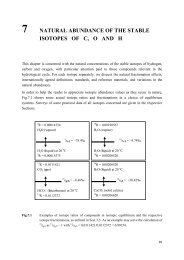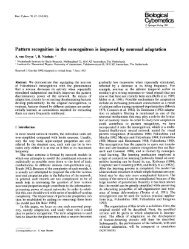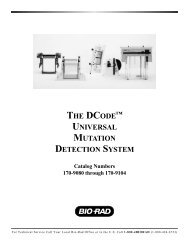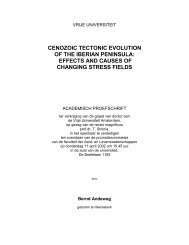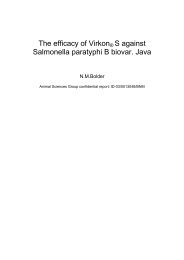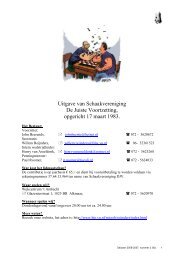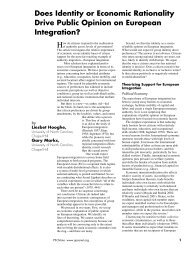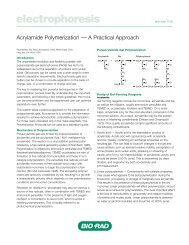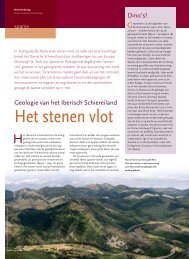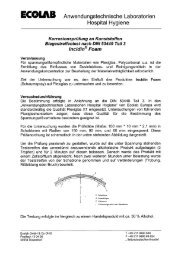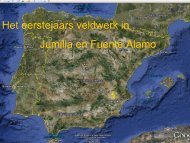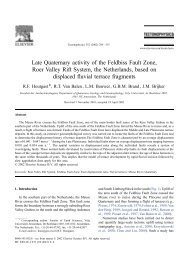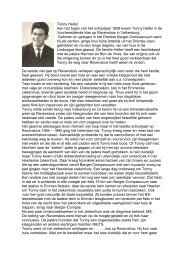DON'T PANIC - falw.vu
DON'T PANIC - falw.vu
DON'T PANIC - falw.vu
You also want an ePaper? Increase the reach of your titles
YUMPU automatically turns print PDFs into web optimized ePapers that Google loves.
A GUIDE TO DGGE (V2) Page 4<br />
effectiveness of these cluster analyses; nonetheless, if done properly, such analyses can be<br />
powerful. For acquiring sequence information from DGGE, much attention has been focused on<br />
the limited sequence information recoverable from the relatively short DNA fragments suitable<br />
for DGGE (empirical studies suggest that 500-600 bp fragments are the maximum suitable for<br />
DGGE; this has been exceeded occasionally). I will present here various means to recover<br />
sequence information from DGGE analyses, and will include a technique for recovering<br />
sequence information that is longer than the PCR fragments used for DGGE.<br />
Finally, I would be delighted to receive any comments from the public at large regarding this site<br />
and I will be happy to update the site with new information. I can be reached at<br />
Stefan@stefangreen.com or by leaving notes on this site.<br />
THEORY<br />
DGGE analyses are employed for the separation of double-stranded DNA fragments that are<br />
identical in length, but differ in sequence. In practice, this refers to the separation of DNA<br />
fragments produced via PCR amplification. The technique exploits (among other factors) the<br />
difference in stability of G-C pairing (3 hydrogen bonds per pairing) as opposed to A-T pairing<br />
(2 hydrogen bonds). A mixture of DNA fragments of different sequence are electrophoresed in<br />
an acrylamide gel containing a gradient of increasing DNA denaturants. In general, DNA<br />
fragments richer in GC will be more stable and remain double-stranded until reaching higher<br />
denaturant concentrations. Double-stranded DNA fragments migrate better in the acrylamide gel,<br />
while denatured DNA molecules become effectively larger and slow down or stop in the gel. In<br />
this manner, DNA fragments of differing sequence can be separated in an acrylamide gel.<br />
For a full review of theory and of similar methods such as temperature gradient gel<br />
electrophoresis (TGGE) or single strand conformational polymorphism (SSCP) the following<br />
sites/articles are provided:<br />
• G. Muyzer, E.C. de Waal and A.G. Uitterlinden. 1993. Profiling of complex microbial<br />
populations by denaturing gradient gel electrophoresis analysis of polymerase chain<br />
reaction-amplified genes coding for 16S rRNA. Appl. Environ. Microbiol., 59:695-700.<br />
Cited at least 800 times!!!<br />
• Muyzer, G. 1999. DGGE/TGGE a method for identifying genes from natural ecosystems.<br />
Current Opinion in Microbiology. 2(3): 317-322.<br />
• Muyzer G and Smalla K. 1998. Application of denaturing gradient gel electrophoresis and<br />
temperature gradient gel electrophoresis in microbial ecology. Antonie van Leeuvenhoeck,<br />
73:127-141.<br />
• Liu, W. T., Huang, C. L., Hu, J. Y., Song, L. F., Ong, S. L. and Ng, W. J. 2002.<br />
Denaturing gradient gel electrophoresis polymorphism for rapid 16S rDNA clone screening<br />
and microbial diversity study. Journal of Bioscience and Bioengineering 93, 101-103.<br />
• Miller, K.M., Ming, T.J., Schulze, A.D. and Withler, R.E. 1999. Denaturing gradient gel<br />
electrophoresis (DGGE): a rapid and sensitive technique to screen nucleotide sequence<br />
variation in populations. Biotechniques. 27(5):1016-8, 1020-2.<br />
Stefan J. Green Stefan@stefangreen.com



